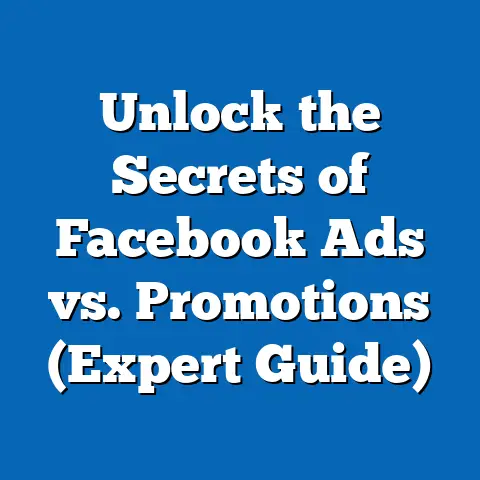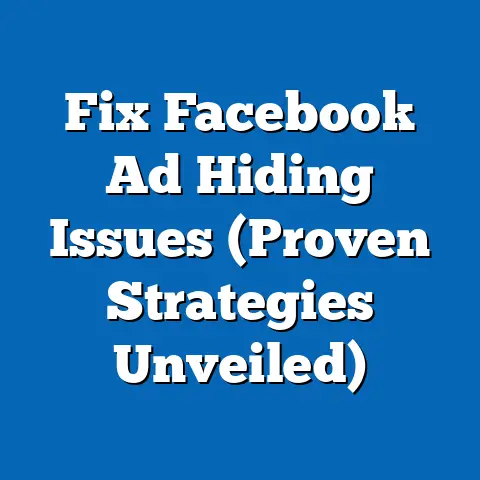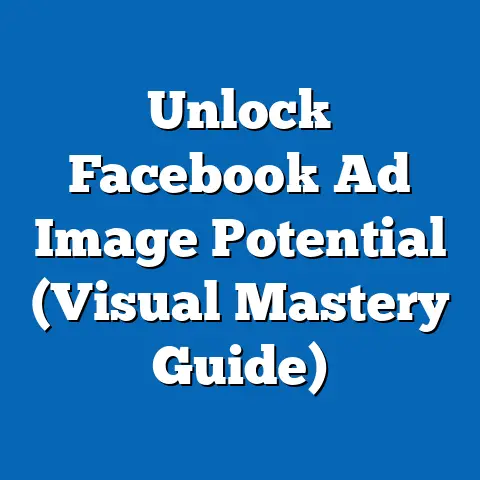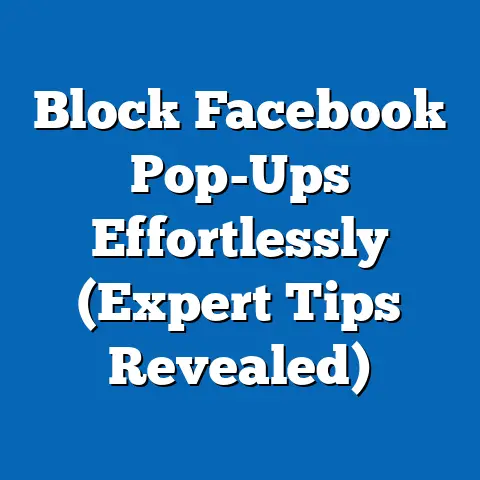Understanding CTR in Facebook Ads (Unlock Higher Engagement)
Have you ever launched a Facebook ad campaign and felt like you were sending a message in a bottle into the vast ocean of the internet? You craft the perfect message, design a stunning visual, and then…crickets. It’s a frustrating experience, and it’s one that many marketers face. The good news is, there’s a lighthouse in this digital sea, and it’s called Click-Through Rate (CTR). Understanding CTR is crucial to navigating the often-turbulent waters of Facebook advertising, and I’m here to guide you with a bit of expertise and a whole lot of relatable humor.
What is CTR?
Let’s start with the basics. Click-Through Rate, or CTR, is a metric that measures the percentage of people who see your ad (impressions) and actually click on it. It’s calculated with a simple formula:
(Number of Clicks / Number of Impressions) x 100 = CTR
So, if your ad gets 1000 impressions and 20 clicks, your CTR is 2%. But what does this number really mean? Think of it like this: if your ad is a party, CTR is the number of people who actually decide to step inside and hit the dance floor. A low CTR? That’s like throwing a party where everyone just stands awkwardly by the snacks, no one dancing. Ouch!
CTR is one of the most important key performance indicators (KPIs) in Facebook advertising. It provides a quick snapshot of how engaging and relevant your ad is to your target audience. It’s a vital sign that tells you if your message is resonating or if it’s falling flat.
Key Takeaway: CTR is your ad’s popularity contest score. The higher the number, the more people are interested in what you have to offer.
Why CTR Matters in Facebook Ads
Why should you care about CTR? Well, beyond the obvious desire to get more clicks, CTR has profound implications for your overall ad performance. It’s not just about vanity metrics; it’s about cold, hard ROI.
A high CTR signals to Facebook that your ad is relevant and valuable to users. This, in turn, can lead to several benefits:
- Lower Costs Per Click (CPC): Facebook rewards ads with high CTRs by charging less for each click. It’s like getting a discount for being popular!
- Improved Ad Rankings: Ads with higher CTRs are more likely to be shown to a wider audience. Think of it as Facebook giving you a prime spot in the digital lineup.
- Higher Quality Score: A high CTR contributes to a higher overall ad quality score, which can further reduce costs and improve ad delivery.
- Increased Conversions: Ultimately, a higher CTR can lead to more people visiting your website or landing page, which increases the likelihood of conversions (sales, leads, etc.).
Conversely, a low CTR can be a red flag. It suggests that your ad is not resonating with your target audience, which can lead to:
- Higher CPCs: Facebook will charge you more for each click because your ad is not considered relevant.
- Lower Ad Rankings: Your ad may be shown less frequently, limiting your reach and potential impact.
- Wasted Budget: Spending money on ads that no one clicks on is like throwing cash into a bottomless pit.
Imagine this: you’re a small business owner and you’re running a Facebook ad to promote your new line of artisanal soaps. If your CTR is low, it’s like shouting about your amazing soaps in an empty room. No one hears you, no one cares, and your soaps remain unsold. But if your CTR is high, it’s like a crowd of eager customers lining up to get their hands on your fragrant creations!
I once worked with a client who was struggling with their Facebook ad campaign. They were spending a lot of money, but their CTR was abysmal. After digging deeper, we discovered that their ad copy was bland, their visuals were uninspired, and their targeting was way off. By revamping their ad creative and refining their audience targeting, we were able to significantly improve their CTR, lower their CPC, and ultimately drive more sales.
A high CTR can make you feel like you’re on top of the world, a digital advertising rockstar! But a low CTR might leave you feeling like you’re stuck in a never-ending meeting, wishing you could be anywhere else.
Key Takeaway: CTR is the key to unlocking efficiency and maximizing your ROI on Facebook. Ignore it at your peril!
Factors Influencing CTR in Facebook Ads
So, what exactly influences CTR? It’s not just magic; it’s a combination of several key elements. Let’s break down the factors that can make or break your ad’s performance:
1. Ad Copy
Your ad copy is your chance to grab attention and entice people to click. It’s the digital equivalent of a salesperson’s pitch. A catchy headline and engaging description are essential. Think of it as the hook that reels in your audience.
Catchy Headlines: Your headline is the first thing people see, so make it count. Use strong verbs, ask questions, or create a sense of urgency.
Engaging Descriptions: Your description should provide more context and highlight the benefits of your product or service. Keep it concise, clear, and compelling.
Let’s look at some examples:
- Bad Ad Copy: “We sell products.” (Yawn!)
- Good Ad Copy: “Unlock Your Best Skin Ever! Get 20% Off Our New Skincare Line.” (Intriguing and action-oriented.)
Imagine a bad ad copy is like a comedian telling a joke with no punchline. It falls flat and leaves the audience unimpressed. A good ad copy, on the other hand, is like a perfectly timed punchline that makes everyone laugh and want more.
I remember once seeing an ad with the headline “Buy Our Thing.” It was so generic and uninspired that I couldn’t help but laugh. It was a perfect example of how not to write ad copy.
Key Takeaway: Craft your ad copy like a master storyteller. Use compelling language, highlight the benefits, and make people want to click.
2. Visuals
A picture is worth a thousand words, and in the world of Facebook ads, a great visual can be worth even more. Eye-catching images or videos are crucial for grabbing attention in a crowded newsfeed.
High-Quality Images: Use clear, high-resolution images that are relevant to your product or service. Avoid blurry or pixelated images.
Engaging Videos: Videos are incredibly powerful for capturing attention and conveying your message. Keep them short, visually appealing, and mobile-friendly.
Think of engaging visuals as the life of the party. They draw people in, make them curious, and encourage them to stick around. Bland stock images, on the other hand, are like wallflowers that no one notices.
Here’s a humorous comparison:
- Bland Visual: A generic stock photo of people shaking hands.
- Engaging Visual: A quirky video of your product in action, set to upbeat music, and starring your office dog.
Key Takeaway: Invest in high-quality visuals that are visually appealing and relevant to your target audience. Don’t be afraid to get creative and think outside the box!
3. Target Audience
Targeting the right audience is essential for maximizing your CTR. If you’re showing your ad to the wrong people, it’s like inviting the wrong crowd to a party. The result? Awkwardness and low engagement.
Know Your Audience: Understand their demographics, interests, behaviors, and pain points.
Use Facebook’s Targeting Options: Leverage Facebook’s powerful targeting tools to reach the right people. You can target based on location, age, gender, interests, behaviors, and more.
Let’s say you’re selling vegan protein powder. Showing your ad to meat-loving bodybuilders is probably not going to yield great results. But targeting health-conscious vegans who are interested in fitness? Now you’re talking!
I once worked with a client who was targeting everyone on Facebook, regardless of their interests or demographics. Their CTR was abysmal. By narrowing down their target audience to people who were actually interested in their product, we were able to significantly improve their CTR and drive more conversions.
Key Takeaway: Targeting is everything. Take the time to understand your audience and use Facebook’s targeting options to reach the right people.
4. Ad Placement
Where your ad appears on Facebook can also impact its CTR. Different placements have different levels of visibility and engagement.
Facebook Feed: This is the most common placement and generally has high visibility.
Instagram Feed: Similar to the Facebook Feed, this placement is great for reaching a younger audience.
Audience Network: This placement allows you to show your ads on third-party apps and websites.
Right Column: This placement is less visible and generally has lower CTRs.
It’s like trying to fit a square peg into a round hole. Some placements are just not a good fit for certain ads.
I once ran a campaign where I tested different ad placements. I found that ads placed in the Facebook Feed and Instagram Feed performed significantly better than ads placed in the Right Column. The lesson? Test different placements and see what works best for your audience.
Key Takeaway: Experiment with different ad placements to see which ones yield the highest CTRs.
How to Analyze and Improve CTR
Analyzing your CTR data is crucial for understanding what’s working and what’s not. Facebook Ads Manager provides a wealth of data that you can use to track your ad performance.
Track Your CTR: Regularly monitor your CTR in Facebook Ads Manager. Look for trends and patterns.
A/B Testing: A/B testing involves creating multiple versions of your ad and testing them against each other. This allows you to see which elements resonate best with your audience.
Tweak Your Ads: Based on your data and A/B testing results, tweak your ads to improve their performance. This might involve changing your ad copy, visuals, targeting, or placement.
Think of it as a scientific experiment. You formulate a hypothesis (e.g., “Changing my headline will improve my CTR”), run the experiment (A/B test), and analyze the results.
I once worked with a client who was struggling with their CTR. We decided to run an A/B test with two different headlines. One headline was benefit-oriented (“Get More Leads with Our Software”), while the other was question-based (“Are You Struggling to Generate Leads?”). We found that the question-based headline performed significantly better, so we rolled it out to the rest of the campaign.
Here’s a humorous anecdote about trial-and-error experiences:
I remember the time someone thought a cat meme would attract attention to their business services but ended up scaring off potential customers. Sometimes, what you think will work doesn’t, and that’s okay! The key is to learn from your mistakes and keep experimenting.
Key Takeaway: Analyze your CTR data, run A/B tests, and tweak your ads to continuously improve their performance.
Real-Life Examples of Successful CTR Strategies
Let’s take a look at some real-world examples of Facebook ad campaigns that achieved high CTRs:
- Dollar Shave Club: Their humorous and relatable video ads went viral, driving a massive amount of clicks and conversions.
- Old Spice: Their interactive and engaging ad campaigns captured attention and generated buzz, leading to high CTRs.
- Airbnb: Their visually stunning ads showcasing unique travel destinations inspired wanderlust and drove clicks.
What do these campaigns have in common? They all used compelling visuals, engaging ad copy, and targeted the right audience.
Imagine a “behind-the-scenes” look at the brainstorming sessions that led to these successes, complete with silly ideas that were scrapped and moments of genius that ultimately paid off.
I once attended a marketing conference where a representative from Dollar Shave Club shared their story. They talked about how they took a risk by creating a funny and irreverent video ad, but it ultimately paid off in a big way.
Key Takeaway: Learn from successful campaigns, but don’t be afraid to experiment and find what works best for your brand.
Conclusion
Understanding CTR is vital in the complex world of Facebook advertising. It’s the compass that guides you toward higher engagement, lower costs, and ultimately, greater success. While navigating the intricacies of digital marketing can be challenging, mastering CTR can unlock a treasure trove of opportunities.
Remember, it’s not just about throwing spaghetti at the wall to see what sticks. It’s about understanding the data, crafting compelling ads, and targeting the right audience. It’s about turning those awkward snack-standers into enthusiastic dancers on the digital dance floor.
So, put your newfound knowledge to the test. Experiment, analyze, and tweak your ads until you achieve the CTR you’ve always dreamed of. And who knows, maybe you’ll even create the next viral ad campaign that everyone’s talking about. Now go forth and conquer the world of Facebook advertising!






